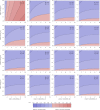Vaccine escape in a heterogeneous population: insights for SARS-CoV-2 from a simple model
- PMID: 34277027
- PMCID: PMC8278051
- DOI: 10.1098/rsos.210530
Vaccine escape in a heterogeneous population: insights for SARS-CoV-2 from a simple model
Abstract
As a countermeasure to the SARS-CoV-2 pandemic, there has been swift development and clinical trial assessment of candidate vaccines, with subsequent deployment as part of mass vaccination campaigns. However, the SARS-CoV-2 virus has demonstrated the ability to mutate and develop variants, which can modify epidemiological properties and potentially also the effectiveness of vaccines. The widespread deployment of highly effective vaccines may rapidly exert selection pressure on the SARS-CoV-2 virus directed towards mutations that escape the vaccine-induced immune response. This is particularly concerning while infection is widespread. By developing and analysing a mathematical model of two population groupings with differing vulnerability and contact rates, we explore the impact of the deployment of vaccines among the population on the reproduction ratio, cases, disease abundance and vaccine escape pressure. The results from this model illustrate two insights: (i) vaccination aimed at reducing prevalence could be more effective at reducing disease than directly vaccinating the vulnerable; (ii) the highest risk for vaccine escape can occur at intermediate levels of vaccination. This work demonstrates a key principle: the careful targeting of vaccines towards particular population groups could reduce disease as much as possible while limiting the risk of vaccine escape.
Keywords: COVID-19; SARS-CoV-2; heterogeneous population; policy; vaccine; vaccine escape.
© 2021 The Authors.
Figures



References
-
- World Health Organization. 2021 Coronavirus disease (COVID-19) weekly epidemiological update – 9 March 2021. www.who.int/docs/default-source/coronaviruse/situation-reports/20210309_... (accessed 12 March 2021).
-
- London School of Hygiene & Tropical Medicine. 2021 COVID-19 vaccine tracker – Living review. https://vac-lshtm.shinyapps.io/ncov_vaccine_landscape/ (accessed 12 March 2021).
-
- Public Health England. 2021 Investigation of SARS-CoV-2 variants of concern in England: Technical briefing 6. https://assets.publishing.service.gov.uk/government/uploads/system/uploa... (accessed 12 March 2021).
Associated data
Grants and funding
LinkOut - more resources
Full Text Sources
Research Materials
Miscellaneous

